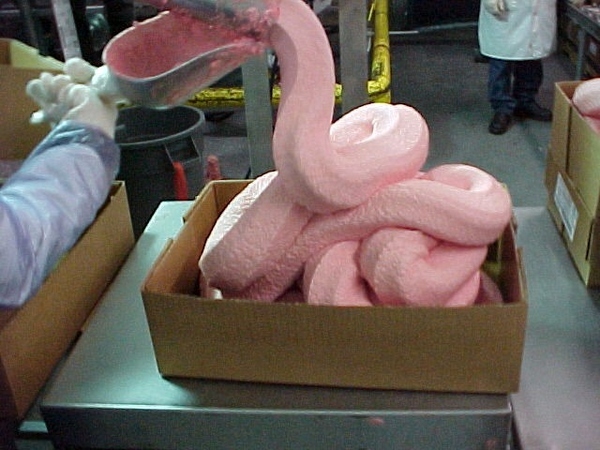Say hello to mechanically separated chicken. It’s what all fast-food chicken is made – things like chicken nuggets and patties. Also, the processed frozen chicken in the stores is made from it.
Basically, the entire chicken is smashed and pressed through a sieve — bones, eyes, guts, and all. it comes out looking like this.
There’s more: because it’s crawling with bacteria, it will be washed with ammonia, soaked in it, actually. Then, because it tastes gross, it will be reflavored artificially. Then, because it is weirdly pink, it will be dyed with artificial color.
But, hey, at least it tastes good, right?
Origins: Mechanically separated meat (MSM) and mechanically separated poultry (MSP) are terms used to refer to products created by mechanization which allows meat processors to recover edible meat tissue from the carcasses of animals. Prior to themid-20th century, a good deal of meat scraps and tissue from food animals such as cows, pigs, chickens, and turkeys went to waste because
processors had no efficient means of separating it from the bones after the rest of the meat had been removed from carcasses. This recovery process was largely done manually (when it was undertaken at all) until the development of machines in the 1960s that automated the process, making it faster, cheaper, and higher-yielding.
Mechanically separated meat is a paste-like or batter-like meat product created by forcing unstripped bones under high pressure through a type of sieve to separate edible meat tissue (including tendons and muscle fiber) from the bones. Contrary to what is claimed above, the process does not involve the grinding up of entire animal carcasses (“bones, eyes, guts, and all”) into one large, amorphous glob of meat; it is a technique for removing what is left on the bones of a carcass after all other processing has been completed. (Also, although meat packing plants typically use anhydrous ammonia for refrigeration purposes, with ammonia leakages having on occasion caused contamination issues at such plants, and sometimes introduce additional ammonium hydroxide into meat as an antibacterial agent, poultry processors do not routinely “soak” MSP in ammonia.)
MSM is typically used in cheaper meat products (such as hot dogs, chicken  nuggets, and frozen dinners) which need not retain the appearance, shape, or texture of “regular” meat. In order to satisfy consumer preferences, food producers may utilize additives in MSM-derived products in order to alter their color, taste, or texture. (Although McDonald’s Chicken McNuggets are typically offered as an example of a popular MSP-based food, since 2003 that product has been made with all white meat rather than MSP.)
nuggets, and frozen dinners) which need not retain the appearance, shape, or texture of “regular” meat. In order to satisfy consumer preferences, food producers may utilize additives in MSM-derived products in order to alter their color, taste, or texture. (Although McDonald’s Chicken McNuggets are typically offered as an example of a popular MSP-based food, since 2003 that product has been made with all white meat rather than MSP.) According to the U.S. Department of Agriculture (USDA), mechanically separated poultry is safe to eat and may be used without restriction, however in commercial food products it must be labeled as such:
Mechanically separated poultry (MSP) is a paste-like and batter-like poultry product produced by forcing bones, with attached edible tissue, through a sieve or similar device under high pressure to separate bone from the edible tissue. Mechanically separated poultry has been used in poultry products since the late 1960′s. In 1995, a final rule on mechanically separated poultry said it was safe and could be used without restrictions. However, it must be labeled as “mechanically separated chicken or turkey” in the product’s ingredients statement. The final rule became effectiveNovember 4,1996. Hot dogs can contain any amount of mechanically separated chicken or turkey.
However, due to concerns over the spread of Bovine Spongiform Encephalopathy (commonly known as “mad cow disease”), the sale of MSM-derived beef products for human consumption in the U.S. was banned in 2004:
In 1982, a final rule published by FSIS (the Food Safety and Inspection Service) on mechanically separated meat said it was safe and established a standard of identity for the food product. Some restrictions were made on how much can be used and the type of products in which it can be used. These restrictions were based on concerns for limited intake of certain components in MSM, like calcium.
Due to FSIS regulations enacted in 2004 to protect consumers against Bovine Spongiform Encephalopathy, mechanically separated beef is considered inedible and is prohibited for use as human food. It is not permitted in hot dogs or any other processed product.
Mechanically separated pork is permitted and must be labeled as “mechanically separated pork” in the ingredients statement. Hot dogs can contain no more than 20% mechanically separated pork.
 +
+








